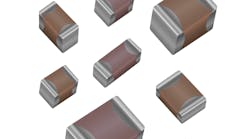Electronics purchasers can expect tight supply and increasing prices for multilayer ceramic capacitors (MLCCs) until at least next year, as demand will continue to outpace supply despite the addition of more capacity by MLCC manufacturers.
Demand for MLCCs is growing across most customer segments, including automotive, defense and aerospace, consumer electronics, industrial, and telecommunications, according to capacitor manufacturers and researchers.
In addition, the “implementation and growth of IoT across markets such as smart homes and buildings [and] smart manufacturing facilities” will further drive MLCC demand over the next several years, said Aravind Seshagiri, global research director - industrials for Frost & Sullivan.
“Even military and space sectors are showing good growth with increased government funding” and are contributing to MLCC demand, Seshagiri added. Another future driver of MLCC demand will be 5G networks, which are starting to be built.
The global MLCC market will grow from about $5.2 billion in 2017 to $5.5 billion in 2018 and continue to rise through 2023, when the market will total $7.4 billion, according to Frost & Sullivan.
Double-Digit Growth Expected
Manufacturers report that while MLCC demand was strong in 2017, it is even more robust in 2018. Roberto Salazar, AVX business manager, said the industry had 15% growth in unit shipments of MLCCs. “As for 2018 vs. 2017, we expect to see growth in the range of 22-25%,” he noted.
Some buyers say the increase in demand for MLCCs is unprecedented and is due to several factors—including healthy overall economic growth, which is boosting demand for industrial equipment, consumer electronics and healthcare products. In addition, spending on defense systems has also increased, further fueling demand for capacitors and other electronic components.
Increasing electronics content in gasoline-powered vehicles, growing demand for electric vehicles, and new, more sophisticated smartphones are also driving MLCC demand. For instance, Apple’s Phone X uses about 1,000 MLCCs, while previous smartphones used 300-400, according to Stephanie Martin, senior vice president global supply for Vexos, an electronics manufacturing services provider based in Markham, Ontario. A conventional gas-powered car uses about 3,000 MLCCs, she said, but an electric vehicle uses 30,000.
Strong unit demand and less-than-ample supply is resulting in higher prices for MLCCs. “Depending on the type of MLCC and application, prices have increased 35-45% from last year, said Seshagiri.
Component manufacturers such as Murata, Vishay, Kemet, TDK, AVX, and others are adding MLCC capacity. For instance, Murata is building a new factory in China which is expected to be completed later this year, the company said.
AVX has been increasing capacity “over the last few years and will continue to do so in the coming years,” said Salazar. “Our expansion plan is focused on the higher reliability type of products. Automotive, space and military is where most of our investment is going into.”
Constrained Supply Continues
However, despite the addition of more capacity, “we expect MLCC supply to continue to be constrained for the rest of 2018,” warned Salazar. “We don't see significant global capacity coming online until late 2019.”
Seshagiri said a lot of capacity being added is for capacitors in smaller case sizes that have higher capacitance values. Smaller case sizes include 0201, 0202, and 015015, and are used in high-volume applications such as smartphones and vehicles. However, OEMs and other customer segments, such as industrial, require larger case sizes such as 0402, 0603, 0805, and 1206; not as much capacity is being added for such parts. In fact, some manufacturers are discontinuing production of some MLCCs in larger case sizes, said Martin.
As a result, she added, while capacity is being added for capacitors in smaller case sizes, there could be shortages or long lead times for MLCCs in large case sizes for a long time.









